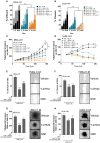IL-4/IL-13 Stimulated Macrophages Enhance Breast Cancer Invasion Via Rho-GTPase Regulation of Synergistic VEGF/CCL-18 Signaling
- PMID: 31214501
- PMCID: PMC6554436
- DOI: 10.3389/fonc.2019.00456
IL-4/IL-13 Stimulated Macrophages Enhance Breast Cancer Invasion Via Rho-GTPase Regulation of Synergistic VEGF/CCL-18 Signaling
Abstract
Tumor associated macrophages (TAMs) are increasingly recognized as major contributors to the metastatic progression of breast cancer and enriched levels of TAMs often correlate with poor prognosis. Despite our current advances it remains unclear which subset of M2-like macrophages have the highest capacity to enhance the metastatic program and which mechanisms regulate this process. Effective targeting of macrophages that aid cancer progression requires knowledge of the specific mechanisms underlying their pro-metastatic actions, as to avoid the anticipated toxicities from generalized targeting of macrophages. To this end, we set out to understand the relationship between the regulation of tumor secretions by Rho-GTPases, which were previously demonstrated to affect them, macrophage differentiation, and the converse influence of macrophages on cancer cell phenotype. Our data show that IL-4/IL-13 in vitro differentiated M2a macrophages significantly increase migratory and invasive potential of breast cancer cells at a greater rate than M2b or M2c macrophages. Our previous work demonstrated that the Rho-GTPases are potent regulators of macrophage-induced migratory responses; therefore, we examined M2a-mediated responses in RhoA or RhoC knockout breast cancer cell models. We find that both RhoA and RhoC regulate migration and invasion in MDA-MB-231 and SUM-149 cells following stimulation with M2a conditioned media. Secretome analysis of M2a conditioned media reveals high levels of vascular endothelial growth factor (VEGF) and chemokine (C-C motif) ligand 18 (CCL-18). Results from our functional assays reveal that M2a TAMs synergistically utilize VEGF and CCL-18 to promote migratory and invasive responses. Lastly, we show that pretreatment with ROCK inhibitors Y-276332 or GSK42986A attenuated VEGF/CCL-18 and M2a-induced migration and invasion. These results support Rho-GTPase signaling regulates downstream responses induced by TAMs, offering a novel approach for the prevention of breast cancer metastasis by anti-RhoA/C therapies.
Keywords: Rho (Rho GTPase); breast cancer; invasion; metastasis; migration.
Figures






Similar articles
-
A novel strategy for specifically down-regulating individual Rho GTPase activity in tumor cells.J Biol Chem. 2003 Nov 7;278(45):44617-25. doi: 10.1074/jbc.M308929200. Epub 2003 Aug 25. J Biol Chem. 2003. PMID: 12939257
-
Taraxacum mongolicum extract inhibited malignant phenotype of triple-negative breast cancer cells in tumor-associated macrophages microenvironment through suppressing IL-10 / STAT3 / PD-L1 signaling pathways.J Ethnopharmacol. 2021 Jun 28;274:113978. doi: 10.1016/j.jep.2021.113978. Epub 2021 Mar 11. J Ethnopharmacol. 2021. PMID: 33716082
-
Tumor-associated macrophages promote invasion while retaining Fc-dependent anti-tumor function.J Immunol. 2012 Dec 1;189(11):5457-66. doi: 10.4049/jimmunol.1201889. Epub 2012 Oct 26. J Immunol. 2012. PMID: 23105143
-
CCL22-Polarized TAMs to M2a Macrophages in Cervical Cancer In Vitro Model.Cells. 2022 Jun 25;11(13):2027. doi: 10.3390/cells11132027. Cells. 2022. PMID: 35805111 Free PMC article.
-
Conventional myosins - unconventional functions.Biophys Rev. 2010 May;2(2):67-82. doi: 10.1007/s12551-010-0030-7. Epub 2010 Mar 9. Biophys Rev. 2010. PMID: 28510009 Free PMC article. Review.
Cited by
-
miR155 deficiency reduces breast tumor burden in the MMTV-PyMT mouse model.Physiol Genomics. 2022 Nov 1;54(11):433-442. doi: 10.1152/physiolgenomics.00057.2022. Epub 2022 Sep 19. Physiol Genomics. 2022. PMID: 36121133 Free PMC article.
-
Breaking Barriers: The Promise and Challenges of Immune Checkpoint Inhibitors in Triple-Negative Breast Cancer.Biomedicines. 2024 Feb 5;12(2):369. doi: 10.3390/biomedicines12020369. Biomedicines. 2024. PMID: 38397971 Free PMC article. Review.
-
Autoimmunity as an Etiological Factor of Cancer: The Transformative Potential of Chronic Type 2 Inflammation.Front Cell Dev Biol. 2021 Jun 21;9:664305. doi: 10.3389/fcell.2021.664305. eCollection 2021. Front Cell Dev Biol. 2021. PMID: 34235145 Free PMC article. Review.
-
Endoplasmic reticulum stress responses in anticancer immunity.Nat Rev Cancer. 2025 Sep;25(9):684-702. doi: 10.1038/s41568-025-00836-5. Epub 2025 Jun 24. Nat Rev Cancer. 2025. PMID: 40555746 Review.
-
MiR-484 suppressed proliferation, migration, invasion and induced apoptosis of gastric cancer via targeting CCL-18.Int J Exp Pathol. 2020 Dec;101(6):203-214. doi: 10.1111/iep.12366. Epub 2020 Sep 28. Int J Exp Pathol. 2020. PMID: 32985776 Free PMC article.
References
Grants and funding
LinkOut - more resources
Full Text Sources
Miscellaneous

